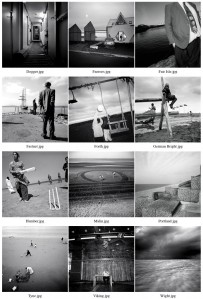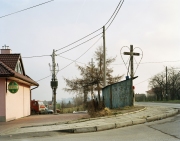Mark Power – (Assignment 3)
The opening speaker at the 2012 Guernsey Photography Festival was the celebrated Magnum photographer Mark Power, professor of photography at Brighton University.
I have to confess that I had not come across him before, but there had been a lot of ‘hype’ about him and his work prior to the Festival and so I went along to his two hour illustrated talk hoping for inspiration, particularly in relation to the assignment I was about to embark upon.
He spoke at some length about the development of his interest in photography, the launch of his professional career, and his acceptance into the Magnum group of photographers.
But it was his vision for long term, self initiated projects that most inspired me. The Shipping Forecast project particularly enthused me, within this body of work and the way which Mark Power approached this assignment I felt some parallel with the photographic missions I enjoy pursuing, – currently Assignment 3 – “The Mood of the Sea”.
Having been brought up listening to the daily Radio 4 broadcast of the shipping forecast, Power came across a tea towel whilst on holiday in Great Yarmouth depicting these iconic shipping areas around the coast of Britain. This re-kindled Powers’ romantic notions of areas such as “Dogger Bank” , “German Bight” and “Fair Isle” which he had had since he was a boy. So, in 1992 he set out to photograph all 31 sea areas, a huge undertaking which took him four years to complete.
Although a number of his images are essentially social documentary photographs, (as opposed to landscape or seascape pictures), I was inspired by the content, enthralled by the his thoughts and his motivation to photograph these far flung areas of the British Isles, and moved by the feeling of adventure, mystery and freedom that Powers’ portrayal of these well known, but unknown, maritime areas gave me. I am always drawn to the artistic portrayal of the sea, and although many of the shots were not seascapes, as I had expected, I was excited to view in large format these enigmatic images.
Furthermore, the presentation of the photographs inspired me, no long editorial text, the images spoke for themselves, alongside which Power had only documented the date the photograph was taken and the 0600hrs shipping forecast for that day. Powerful (!) in its simplicity.
The remarkable series of photographs collected here is the culmination of four years work, a sustained windswept journey to the outskirts of Britain and beyond……..
………. If the overall effect of Power’s work is to challenge and confound expectation, his success is
also that he has beautifully resolved a personal preoccupation through his chosen medium.
Postcards from the Edge –David Chandler (introduction to The Shipping Forecast, November 1996)
This quote, is just the framework of an analytical essay written by David Chandler about Mark Powers’ project ‘The Shipping Forecast’. It makes very interesting, informative and thought provoking reading. It has certainly made evaluate the value, philosophy and psychology of my own work, and the need to have a passion(personal preoccupation) about the subjects you are photographing.
Following ‘The Shipping Forecast’ Power has photographed a number of further projects including ‘Superstructure’ – a series of photographs documenting the building of the Millennium Dome and ‘The Treasury Project’ images of the renovation of the governments’ treasury building at Whitehall. In both of these portfolios the photographs tend to be a pictorial record of these buildings, in my opinion they show little imagination and artistic flair. Certainly not inspirational in content, but interesting to ponderhow such a body of work became to be renowned
In 2003 Power embarked on a second personal, and to my mind, more interesting project. He took the A – Z map book of London as his inspiration and set about photographing the peripheral boundaries of the map. He titled this work ’26 Different Endings’.
This project is a fascinating exploration of the mundane yet completely familiar view of a British city. Photographed with a large format camera, I find it interesting that Power has chosen to photograph these urban landscapes in colour, as opposed to black and white which I feel would have imparted a further feeling of desolation, forgotten space and the ordinary.
However, I like the concept, from the point of inspiration to the outcome, with an adventurous journey with a camera in between. This project of Mark Powers’ certainly sits well with work I have undertaken.
It does make me think I should make more of the environmental landscape portfolios I have sitting on my hard drive!
Mark Power has worked on many more lengthy assignments, most of which have taken him a number of years to complete and some of which are ongoing. In his lecture he talked about the way he worked, his collaboration with literary artists, and his embracing of external influences to improve and inspire his own photography.
Powers latest project was also featured both in his talk and in the exhibition of his work. ‘Sound of Two Songs’ is a body of work that portrays the effect on Poland as it entered the EU. Commissioned by Magnum to spend a month in Poland documenting the impact on Polish life as the country joined the European community, Powers’ focus shifted from focusing on the people of Poland and how their lives changed, to the landscape of this poor, war- torn country and how it is viewed by an outsider now that Poland has become more accessible to the western world – from a respectable distance!
In these three images of Poland taken from The British Journal of Photography , I found it quite remarkable how similar the images were to those taken on the outskirts of London in his ’26 Different Endings’ project. Bland, undeveloped, dull and for the much part wasteland; reflecting Powers’ style of photography and his interest in this barren environment , this everyday view of life. Here he uses landscape photography in order to make a social statement.
I have to say that whilst not all of Mark Power’s photography inspires me, his subject matter and bland portrayal of shabby, off-beat scenes is not to my taste, I appreciate the thought process that goes behind each body of work, his wish to portray to the viewer the significance of these landscapes in a society, and the passion he has for the subjects he photographs.
From listening to Mark Power’s illustrated talk and viewing his work, I have learnt that inspiration for a project can come from the most unexpected places; that time, patience, vision and an unwavering enthusiasm is important in order to compile a meaningful body of work; that landscape photography can influence social conscience.
Also that images within a project portfolio should have some sequencing and cohesion in order to give structure to the total outcome







